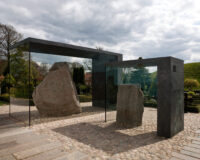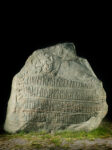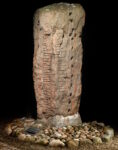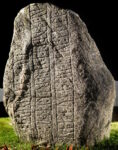 Researchers at the National Museum of Denmark have identified the carver of the runes on the iconic Jelling Stone. His name was Ravnunge-Tue and his boss was Queen Thyra of Jelling (d. 958 A.D.), wife of King of Denmark Gorm the Old (d. 958-9) and mother of Harald Bluetooth, king of Denmark and Norway (ca. 911 – 985 A.D.).
Researchers at the National Museum of Denmark have identified the carver of the runes on the iconic Jelling Stone. His name was Ravnunge-Tue and his boss was Queen Thyra of Jelling (d. 958 A.D.), wife of King of Denmark Gorm the Old (d. 958-9) and mother of Harald Bluetooth, king of Denmark and Norway (ca. 911 – 985 A.D.).
 The large Jelling Stone has been dubbed Denmark’s birth/baptismal certificate because the runic inscription uses the name “Denmark” (“Danmǫrk” in Old Norse) and refers to its conversion to Chritianity. Harald Bluetooth had it carved as a memorial monument for his parents, but added his own credits at the end, describing himself as “that Haraldr who won for himself all of Denmark and Norway and made the Danes Christian.”
The large Jelling Stone has been dubbed Denmark’s birth/baptismal certificate because the runic inscription uses the name “Denmark” (“Danmǫrk” in Old Norse) and refers to its conversion to Chritianity. Harald Bluetooth had it carved as a memorial monument for his parents, but added his own credits at the end, describing himself as “that Haraldr who won for himself all of Denmark and Norway and made the Danes Christian.”
The smaller of the Jelling stones is the earlier of the two. It was erected by Gorm the Old as a memorial to Thyra whom he lovingly describes as “Denmark’s adornment.”
3D scans of runestones enable researchers to gain a close-up view of traces of the carving process. This means they can tell the carving technique of the different rune stones apart. Every experienced stonemason holds his chisel at a certain angle and strikes the hammer with a specific force: this is visible in the angle of the traces of the carving and the distance between them. The motor function developed in such work is individual.
 The carving technique on the large Jelling Stone matches that of the runes on the Læborg Stone found in a field near Læborg Church 20 miles southwest of Jelling. The author helpfully signed the inscription on the Læborg Stone. It reads: “Ravnunge-Tue carved these runes in memory of Thyra, his queen.” He also gave himself and his two collaborators credit on the Bække 1 runestone found a mile from Bække Church. That inscription reads: “Ravnunge-Tue and Fundin and Gnyple, these three made Thyra’s mound.”
The carving technique on the large Jelling Stone matches that of the runes on the Læborg Stone found in a field near Læborg Church 20 miles southwest of Jelling. The author helpfully signed the inscription on the Læborg Stone. It reads: “Ravnunge-Tue carved these runes in memory of Thyra, his queen.” He also gave himself and his two collaborators credit on the Bække 1 runestone found a mile from Bække Church. That inscription reads: “Ravnunge-Tue and Fundin and Gnyple, these three made Thyra’s mound.”
 In total, seven of the runestones in Jutland were 3D scanned for this project: the two Jelling stones, the two Bække stones, the Læborg stone, the Home stone and the Randbøl stone. The runes on the smaller Jelling Stone were too worn for the signature chiseling techniques to be detectable. It’s possible Ravnunge-Tue carved that one too.
In total, seven of the runestones in Jutland were 3D scanned for this project: the two Jelling stones, the two Bække stones, the Læborg stone, the Home stone and the Randbøl stone. The runes on the smaller Jelling Stone were too worn for the signature chiseling techniques to be detectable. It’s possible Ravnunge-Tue carved that one too.
This identification answers a long-standing question about whether the Queen Thyra mentioned on the Jelling Stones was the same person as the Thyra mentioned on the Læborg Stone. The fact that Thyra and Gorm’s rune carver made the runes on the large Jelling Stone as well as the Læborg runes strongly suggests this was the same queen, not two people who happened to share a popular name. That means Queen Thyra was on at least four rune stones, more runic mentions than anyone else in Viking era Denmark, twice the number of mentions her husband and son got.
“This means that Queen Thyra was far more important than we previously assumed. She probably came from a nobler, older family than Gorm the Old, whom we usually refer to as the first King of Denmark. This is extremely interesting when it comes to understanding the power structure and the genesis of Denmark as a nation,” says [Denmark National Museum runologist] Lisbeth Imer.
All four rune stones that mention Thyra are located in Southern Jutland, implying that her power was based in this area, while Gorm the Old may have come from elsewhere.
Unni is revered as third Apostle of the North and as Saint, he was archbishop of Hamburg-Bremen (916 – 936AD). According to the ‘Gesta Hammaburgensis’, back then, “Dani quoque S(c)lavos auxilio habentes” had plundered first the transalbian Saxons, then the cisalbian ones, and they had terrorized much of Saxony.
Their king had been Gorm (“Hardecnudth Worm”), who drove all Christian priests out of Denmark and had many of them cruelly killed (“per tormenta necavit”). However, in 934AD, Henry the Fowler invaded Denmark and right away had subdued king Gorm, but due to Gorm’s “inherent ferocity”, he could not be “flexed”.
Contrastingly, bishop Unni had been much more successful with Gorm’s son Harald (“filium autem regis Haroldum”, a.k.a ‘Bluetooth’), who –after a longer process– “ipse haberi publice permitteret”, allowed to have public Christian service. As it here turns out, his mom Queen Thyra may also have been involved.
If Queen Thyra got more “runic mentions than anyone else in Viking era Denmark, twice the number of mentions her husband and brother got”, she indeed may have lived longer than Gorm, which also would explain why she, according to Saxo Grammaticus, married Tofi after Gorm had died.
I’m surprised these rune stones are not protected from the weather given freezing conditions can cause the rocks to fracture.
You are quite right; I visited the Jelling stones back in the 1970’s, and back then I noticed that a large part of the inscription on king Gorm’s stone had broken lose from the ‘core’ of the stone.
I’m quite certain that a medium-hard blow could have made the surface crumble; fortunately that didn’t happen.
A few years ago the stones were protected by glass casings, so they should be safe – for now.
“ Ravnunge-Tue ” translates roughly as “ Raven-Cub Tue “, Tue being a male name derived from Thor, the viking god of thunder
I mostly agree with Otto’s remark, but I must emphasise that his last paragraph is apparently based on Saxo’s falling for an urban legend; in this case Gorm’s stone must be viewed as the primary source.
The reason Thyra (Thorvi) is mentioned so often may very well be that many inscriptions have been lost over time. It may even be that a lot of runic stones were intentionally destroyed shortly after the transition to Christianity because they reminded people of their ‘pagan’ past. The reason that the stones mentioning Thorvi survived, might be that she played an active role in that transition. – that is just my personal hunch.
What does the name GNYPLE mean?